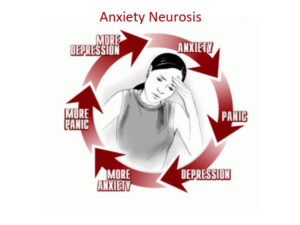How Does Yoga Define Anxiety And Depression?
 Yogis, the Indian scientists, to understand the nature of the universe turned inwards and began their experiments on the most highly evolved stuff of this universe – the human mind and arrived at fascinating truths. Sage Vasista asks us to do an experiment to find an answer to the question, “what is your state when you are in acute anxiety ?” Let us see how Prasad and Pratiksha bring out this point. Prasad: please try and remember your experience of a terrible anxiety or fear or depression you went through in your life. Pratiksha: Oh! Yes, recently just 2 months ago, I made a big mess of myself when I had to face the interview for my job. Prasad: Tell me where was that anxiety? Pratiksha: It was obviously starting as an intense distress or a fear in my mind but it soon gave me palpitation, tremors and I started sweating profusely. Prasad: Yes, you are right, just 2 minutes before you entered the interview room, when you were in a terrible confusion, the thoughts were “My god, how I wish I do very well, what if I do not do well, I do not think I can do well” these thoughts but it had picked up enormous speed. It was so quick that it went beyond your capacity to comprehend it. The speed peredated into the body when the heart speeded up, breathing speeded up and led to this great confusion. Prasad: What the sage tell us is that in all our emotions like extreme fear, anxiety, anger, frustation and even depression, the problem is that of uncontrolled surge of this speed, first at the level of the mind, which goes on to disturb the energy (práïa) balance, percolates into extremely speeded up or blocked functions of the body resulting in physiological responses of anxiety or depression. Prartiksha: My good God. It is very interesting. It sounds very simple. It is very practical. I can now see what you want to say further. I can see that speed is the root cause of all the problems I had. The answer should be to get mastery over this speed. All that I have to do is to ‘run the car slowly initially so that I do not get into accidents.’ Is this what you want to say? Prasad: When Srirama was in deep depression, sage Vasiúta gives him this truth and tells him “Manah prasamana upayah yogah” – (mind slowing down trick is yoga) and goes on to give very simple hints of breathing to get mastery over the mind.
Yogis, the Indian scientists, to understand the nature of the universe turned inwards and began their experiments on the most highly evolved stuff of this universe – the human mind and arrived at fascinating truths. Sage Vasista asks us to do an experiment to find an answer to the question, “what is your state when you are in acute anxiety ?” Let us see how Prasad and Pratiksha bring out this point. Prasad: please try and remember your experience of a terrible anxiety or fear or depression you went through in your life. Pratiksha: Oh! Yes, recently just 2 months ago, I made a big mess of myself when I had to face the interview for my job. Prasad: Tell me where was that anxiety? Pratiksha: It was obviously starting as an intense distress or a fear in my mind but it soon gave me palpitation, tremors and I started sweating profusely. Prasad: Yes, you are right, just 2 minutes before you entered the interview room, when you were in a terrible confusion, the thoughts were “My god, how I wish I do very well, what if I do not do well, I do not think I can do well” these thoughts but it had picked up enormous speed. It was so quick that it went beyond your capacity to comprehend it. The speed peredated into the body when the heart speeded up, breathing speeded up and led to this great confusion. Prasad: What the sage tell us is that in all our emotions like extreme fear, anxiety, anger, frustation and even depression, the problem is that of uncontrolled surge of this speed, first at the level of the mind, which goes on to disturb the energy (práïa) balance, percolates into extremely speeded up or blocked functions of the body resulting in physiological responses of anxiety or depression. Prartiksha: My good God. It is very interesting. It sounds very simple. It is very practical. I can now see what you want to say further. I can see that speed is the root cause of all the problems I had. The answer should be to get mastery over this speed. All that I have to do is to ‘run the car slowly initially so that I do not get into accidents.’ Is this what you want to say? Prasad: When Srirama was in deep depression, sage Vasiúta gives him this truth and tells him “Manah prasamana upayah yogah” – (mind slowing down trick is yoga) and goes on to give very simple hints of breathing to get mastery over the mind.
SPINAL STRETCH – With Legs Apart
Sthiti: Tadasana
l Spread your legs apart as far as comfortable l Keep your hands stretched above your head.
Practice
l While exhaling bend forward from the waist. l Catch the right foot with both hands and try to touch the right knee with the forehead. l Come up while inhaling and raise the hands above the head. l Repeat the same on the other side l Repeat about 25 times on alternate sides.
NOTE
l Do not bend the knees during the practice. l Increase the speed gradually to your maximum capacity.
How does yoga work in Anxiety and Depression?
The technique is to start with loosening exercises which are body movements repeated with jerks and speed. This helps initially to distract the mind from the loop of repeating anxiety producing thoughts. Once it is distracted by fast body movements you go on to slower body movements (Suryanamaskar and yogasanas). Similarly one can start with fast breathing practices (like Kapalabhati) and then move on to slower breathing practices (pranayama). After alternating between a set of alternating fast and slow body and breathing practices for about 20-30 minutes, mind is pulled out of its loop of worrying thoughts. Now it can be set into further slowing down by Nadanusandhana, and then to actual meditation which is nothing but very slow effortless flow of a single thought in the mind sinking down into total inner silence for a few seconds.
Has Yoga helped persons with anxiety and depression?
Yes, research organizations has systematically recorded case histories of large number of patients with various types of anxiety and depression, and also followed them up for 2 weeks to 10 years after yoga practices. Dr. Horia Crisan, a medical graduate from Germany worked with us in 1980 studied the effect of 4 weeks of práïáyáma practice in 19 cases of carefully diagnosed cases of general anxiety and showed statistically significant reduction in their anxiety scores, pulse rate, blood pressure, and also a reduction in the urinary excretory product (urinary VMA) of adrenaline. Further, 129 subjects with different forms of anxiety including panic Issuess, phobias and general anxiety Issues were studied during 1996-98. Within 2 weeks, the self rating anxiety scores, psychophysiological check list and the anti anxiety meditation scores reduced significantly after the practice of integrated approach of yoga therapy as described in this book. Dr. Jayakiramiah et.al(2000) in 45 subjects with melancholia, compared the efficiency of Electrocovulsive therapy, imipramine and Sudarshan Kriya Yoga and concluded that Sudarshan Kriya Yoga is potential alternative to Supplement as a from of complementary Management.
ALTERNATE BHUJANGÁSANA AND PARVATÁSANA
Stage I: Bhujangásana Sthiti: Prone Posture
l Assume the prone Sthithi posture. l Bring the palms on either side of the chest. Practice l While inhaling progressively raise the head, the upper portion of the trunk and the back arching the trunk as far as back you can until the elbows are straight.
Stage II : Parvatásana
l While exhaling raise the buttocks and lower the head to look at the toes. Heels touch the ground. l This is one round of practice. l Repeat rapdily 10 to 20 times. l Come back to Sthiti position. l Relax in Makarásana
Acknowledgement to:
- CYT / ATTC Students of Union Yoga Ayurveda Singapore
- Swami Vivekananda Yoga Prakashana Trust, Bangalore
Disclaimer
Yoga Ayurveda Therapy is Complementary Medicine and doesn't alternates any conventional treatment.
Yoga-Ayurveda Therapy needs physical assistance which may need physical touch. You can ask teacher or therapist not to give physical touch or assistance and based on whatever you choose, our teacher or therapist will follow the instructions. Any point you want to change the preference, then please inform teacher or therapist and management in writing. You will take responsibility of your decision and will not hold Union Yoga Ayurveda responsible for any kind of damage.
All kind of Yoga Ayurveda teaching and therapy can cause certain injuries and you are accepting those injuries. Signing up for the therapy or yoga courses means that you are aware of the probable injuries.
Union Yoga Ayurveda (Union Centre Pte Ltd) and its staff are not liable or responsible for any injuries caused during the session which are visible or not visible, physical or hormonal or mental. You as client take full responsibility of your own decision and will not claim any kind of compensation in terms of money or any resources for the damage caused because of due process.
Related Topics
- Yoga Therapy & Common Ailments
- Diabetes Mellitus
- Yoga & Glaucoma
- Chronic Myeloid Leukemia
- Gastro-Esophageal Reflux / Gastritis
- High Blood Pressure
- For Anxiety neurosis, Depressions etc
- For Neurological issues
- Cataract and short / long Sightedness
- Scoliosis / Herneated disc / Sciatica
- Menstrual Issues

